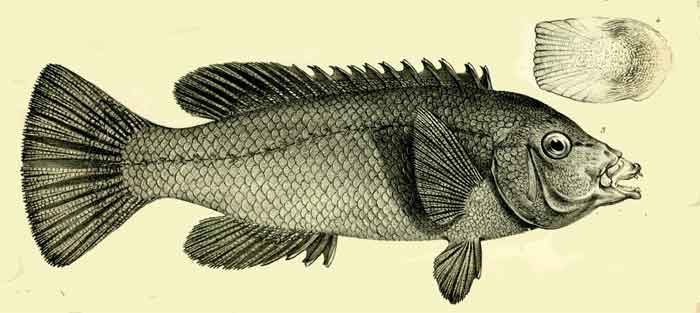Superregnum: Eukaryota
Regnum: Animalia
Subregnum: Eumetazoa
Cladus: Bilateria
Cladus: Nephrozoa
Superphylum: Deuterostomia
Phylum: Chordata
Cladus: Craniata
Subphylum: Vertebrata
Infraphylum: Gnathostomata
Megaclassis: Osteichthyes
Superclassis/Classis: Actinopterygii
Classis/Subclassis: Actinopteri
Subclassis/Infraclassis: Neopterygii
Infraclassis: Teleostei
Megacohors: Osteoglossocephalai
Supercohors: Clupeocephala
Cohors: Euteleosteomorpha
Subcohors: Neoteleostei
Infracohors: Eurypterygia
Sectio: Ctenosquamata
Subsectio: Acanthomorphata
Divisio/Superordo: Acanthopterygii
Subdivisio: Percomorphaceae
Series: Eupercaria
Ordo: Labriformes
Familia: Labridae
Genus: Achoerodus
Species: A. gouldii – A. viridis
Name
Achoerodus Gill, 1863:222
Type species: Labrus gouldii Richardson, 1843. Type by original designation (also monotypic).
References
Gill, T.N. 1863: Notes on the labroids of the western coast of North America. Proceedings of the Academy of Natural Sciences of Philadelphia, 15: 221–224.
Parenti, P. & J.E. Randall 2000: An annotated checklist of the species of the Labroid fish families Labridae and Scaridae. Ichthyological Bulletin of the J. L. B. Smith Institute of Ichthyology, 68: 1–97.
Vernacular names
English: Gropers

Achoerodus gouldii
Achoerodus is a genus of wrasses collectively known as blue gropers. They are found in the coastal waters of southern Australia and distinguished by the bright blue colouring of the adult males.
The thick-bodied blue gropers have peg teeth, heavy scales, large tails and thick lips. Juveniles are brown to green brown. Adult females are brown to greenish-yellow. Each scale may have a darker red spot. The adult males have the bright blue colouring that give the fish their name. The blue can range from deep navy to cobalt blue, and there may also be darker or yellow-orange spots or lines around the eyes.
All blue gropers begin life as females. As they mature, they go through an initial phase, in which they may be male or female, before developing their adult colouring and reaching the terminal phase.
Typically you will only find one or two male blue gropers in an area, with a larger number of the female gropers in the same area. Should the dominant male blue groper die, the largest female will grow, change colour and sex, and become the dominant male.
In Australia certain states like New South Wales have granted protection to this species. It's considered the state fish symbol for the territory and it is illegal to spear blue groper. There is also a limitation on fishing for them with a line. They are extremely inquisitive, and while it is now discouraged to feed them by cutting up urchins, they still will approach divers as if expecting to be fed. Their lifespan is said to be up to 35 years according to some sources, longer according to others.
The fish live in a variety of coastal waters, especially exposed reefs.
In 1998, the eastern blue groper was made the state fish emblem of New South Wales.[1]
Species
The currently recognized species in this genus are:[2]
Achoerodus gouldii (J. Richardson, 1843) (western blue groper)
Achoerodus viridis (Steindachner, 1866) (eastern blue groper)
References
"Symbols & Emblems of NSW". Archived from the original on 27 March 2010. Retrieved 7 March 2010.
Froese, Rainer and Pauly, Daniel, eds. (2013). Species of Achoerodus in FishBase. August 2013 version.
"Eastern Blue Groper". Fishes. Australian Museum. Archived from the original on 11 October 2006. Retrieved 11 November 2006.
"Blue Groper". Sportsfish Australia. Archived from the original on 15 November 2006. Retrieved 11 November 2006.
"Eastern Blue Groper". Fish'n'kids. New South Wales Department of Primary Industries. Archived from the original on 17 October 2006. Retrieved 11 November 2006.
"Eastern Blue Groper". Marine Education Society of Australasia. Retrieved 27 January 2015.
Retrieved from "http://en.wikipedia.org/"
All text is available under the terms of the GNU Free Documentation License

